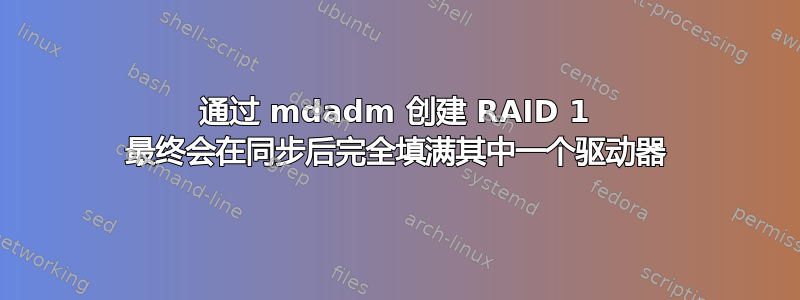
我有一台配备 2 个 1TB NVMe 驱动器的服务器,我希望它们在软件 RAID 1(mdadm)中作为系统驱动器工作。创建并等待阵列同步后,我发现阵列中的一个驱动器已完全填满。通过nvme list或检查df -h显示它们看起来完全未同步。首先,我从 Hetzner(拍卖)购买了一台新服务器,在自动安装 Ubuntu 20.04 LTS 并等待驱动器重新同步后,我注意到了这个问题,移除这个已满的驱动器并再次添加到 mdadm 没有帮助。已经通过重新安装到 22.04 进行了测试 - 同样的问题。然后在 Hetzner Rescue 系统中手动格式化和设置此阵列。驱动器同步后我总是以此结束(它们两个都只是有清晰的操作系统)我总是以以下方式结束nvme list:
Node SN Model Namespace Usage Format FW Rev
---------------- -------------------- ---------------------------------------- --------- -------------------------- ---------------- --------
/dev/nvme0n1 S3W6NX0Mxxxxxx SAMSUNG MZVLB1T0HALR-00000 1 19.80 GB / 1.02 TB 512 B + 0 B EXA7301Q
/dev/nvme1n1 S3W6NX0Mxxxxxx SAMSUNG MZVLB1T0HALR-00000 1 1.02 TB / 1.02 TB 512 B + 0 B EXA7301Q
lsblk:
NAME MAJ:MIN RM SIZE RO TYPE MOUNTPOINT
loop0 7:0 0 3.1G 1 loop
nvme0n1 259:0 0 953.9G 0 disk
├─nvme0n1p1 259:1 0 32G 0 part
│ └─md0 9:0 0 32G 0 raid1
├─nvme0n1p2 259:2 0 1G 0 part
│ └─md1 9:1 0 1022M 0 raid1
└─nvme0n1p3 259:3 0 920.9G 0 part
└─md2 9:2 0 920.7G 0 raid1
nvme1n1 259:4 0 953.9G 0 disk
├─nvme1n1p1 259:8 0 32G 0 part
│ └─md0 9:0 0 32G 0 raid1
├─nvme1n1p2 259:9 0 1G 0 part
│ └─md1 9:1 0 1022M 0 raid1
└─nvme1n1p3 259:10 0 920.9G 0 part
└─md2 9:2 0 920.7G 0 raid1
fdisk -l:
Disk /dev/nvme0n1: 953.87 GiB, 1024209543168 bytes, 2000409264 sectors
Disk model: SAMSUNG MZVLB1T0HALR-00000
Units: sectors of 1 * 512 = 512 bytes
Sector size (logical/physical): 512 bytes / 512 bytes
I/O size (minimum/optimal): 512 bytes / 512 bytes
Disklabel type: dos
Disk identifier: 0x95d349e3
Device Boot Start End Sectors Size Id Type
/dev/nvme0n1p1 2048 67110911 67108864 32G fd Linux raid autodetect
/dev/nvme0n1p2 67110912 69208063 2097152 1G fd Linux raid autodetect
/dev/nvme0n1p3 69208064 2000407215 1931199152 920.9G fd Linux raid autodetect
Disk /dev/nvme1n1: 953.87 GiB, 1024209543168 bytes, 2000409264 sectors
Disk model: SAMSUNG MZVLB1T0HALR-00000
Units: sectors of 1 * 512 = 512 bytes
Sector size (logical/physical): 512 bytes / 512 bytes
I/O size (minimum/optimal): 512 bytes / 512 bytes
Disklabel type: dos
Disk identifier: 0x76027d35
Device Boot Start End Sectors Size Id Type
/dev/nvme1n1p1 2048 67110911 67108864 32G fd Linux raid autodetect
/dev/nvme1n1p2 67110912 69208063 2097152 1G fd Linux raid autodetect
/dev/nvme1n1p3 69208064 2000407215 1931199152 920.9G fd Linux raid autodetect
Disk /dev/md0: 31.97 GiB, 34325135360 bytes, 67041280 sectors
Units: sectors of 1 * 512 = 512 bytes
Sector size (logical/physical): 512 bytes / 512 bytes
I/O size (minimum/optimal): 512 bytes / 512 bytes
Disk /dev/md1: 1022 MiB, 1071644672 bytes, 2093056 sectors
Units: sectors of 1 * 512 = 512 bytes
Sector size (logical/physical): 512 bytes / 512 bytes
I/O size (minimum/optimal): 512 bytes / 512 bytes
Disk /dev/md2: 920.74 GiB, 988638674944 bytes, 1930934912 sectors
Units: sectors of 1 * 512 = 512 bytes
Sector size (logical/physical): 512 bytes / 512 bytes
I/O size (minimum/optimal): 512 bytes / 512 bytes
mdadm -D /dev/md2(最大音量)
/dev/md2:
Version : 1.2
Creation Time : Fri Sep 2 01:43:35 2022
Raid Level : raid1
Array Size : 965467456 (920.74 GiB 988.64 GB)
Used Dev Size : 965467456 (920.74 GiB 988.64 GB)
Raid Devices : 2
Total Devices : 2
Persistence : Superblock is persistent
Intent Bitmap : Internal
Update Time : Fri Sep 2 03:06:37 2022
State : clean
Active Devices : 2
Working Devices : 2
Failed Devices : 0
Spare Devices : 0
Consistency Policy : bitmap
Name : rescue:2 (local to host rescue)
UUID : 9140be20:6c29229f:d572b5ba:dee1f0a3
Events : 895
Number Major Minor RaidDevice State
0 259 3 0 active sync /dev/nvme0n1p3
1 259 10 1 active sync /dev/nvme1n1p3
和cat /proc/mdstat
Personalities : [raid1]
md2 : active raid1 nvme1n1p3[1] nvme0n1p3[0]
965467456 blocks super 1.2 [2/2] [UU]
bitmap: 0/8 pages [0KB], 65536KB chunk
md1 : active raid1 nvme1n1p2[1] nvme0n1p2[0]
1046528 blocks super 1.2 [2/2] [UU]
md0 : active raid1 nvme1n1p1[1] nvme0n1p1[0]
33520640 blocks super 1.2 [2/2] [UU]
unused devices: <none>
在我看来一切都很正常,有人知道为什么阵列重新同步后第二个驱动器会完全填满吗?只是要说一下,这不是我在 Hetzner 上的第一台服务器 - 其他类似配置的服务器在使用上没有区别。
答案1
“重新同步”过程意味着“确保驱动器上的数据一致”。请注意,MD RAID 是一个单独的块级设备,它对上面的内容一无所知。文件系统?不知道。LVM?可能。原始 Oracle ASM 表空间?也许。根本没有使用?这种情况会发生。组装后,MD RAID 将继续工作,并确保所有组件设备彼此一致。这就是它所能做的一切,也是它的设计目的。
因此,为了确保两个 RAID1 设备一致,它只是将一个设备逐块复制到另一个设备。读取一个驱动器输出的任何数据并将其写入另一个驱动器。它不关心该块中存储了什么数据(以及该块是否由文件系统使用);它只是指示一个设备的 M 到 N 块应该与另一个设备上的 M 到 N 块相同。这意味着,在重新同步期间至少会有一个驱动器被完全写入。
可以稍微缓解这种情况的方法是事后修剪驱动器。您可以向RAID 本身,如果启用了向下传递,它会将其转换为 NVMe 命令。要检查这一点,您可以执行lsblk --discard。要进行修剪,您可以例如创建一个跨越整个阵列的文件系统并将fstrim其。


